In Alabama, owls are like silent ninjas of the sky. I’ve looked into these night-time birds, including cool ones like the Barred Owl and the mighty Great Horned Owl. They love living everywhere in Alabama, from the busy cities to the quiet woods. Owls help keep nature in balance, but lots of folks don’t know much about them. So, let’s dive in and learn all about how these awesome owls live and what’s being done to make sure they stick around for a long time.
Here we’ll learn about 7 different types of Owls in Alabama
1. Eastern Screech-Owl
- Scientific name: Megascops asio
- Life span: 8 to 10 years
- Size: 16 to 25 cm
- Weight: 121 to 244 g
- Wingspan: 46 to 61 cm
- Status: Least Concern
The Eastern Screech-Owl is a cool bird that’s super good at living with humans in North America, even in Mexico. These owls come in two colors: red in the south and grey in the north, probably to match the woods they live in.
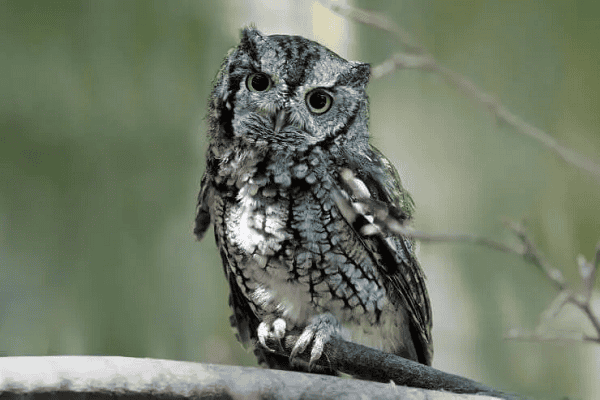
These owls like to be alone, but in April, they find a partner and stick together for life. They make their homes in tree holes in thick forests. Usually, they stay with one mate, but sometimes the guys might have more than one mate in a season.
They eat lots of different things, like small animals, bugs, and even some fruits. At night, they use their super hearing to find food and then spit out the bits they can’t eat, like bones and fur.
The Eastern Screech-Owl isn’t in danger of disappearing, but it can get sick from eating poisoned animals or lose its home if the forest is messed up.
2. Great Horned Owl
- Scientific name: Bubo virginianus
- Life span: 25 – 50 years
- Size: 43 to 64 cm
- Weight: 1200 to 1600 g
- Wingspan: 91 to 153 cm
- Status: Least Concern
The Great Horned Owl is like a chameleon of the bird world. It can blend into different places, from deserts to forests, even down to Brazil. These night owls have speckled feathers that help them hide. And those “horns”? They’re actually fancy feathers, maybe for talking to other birds.
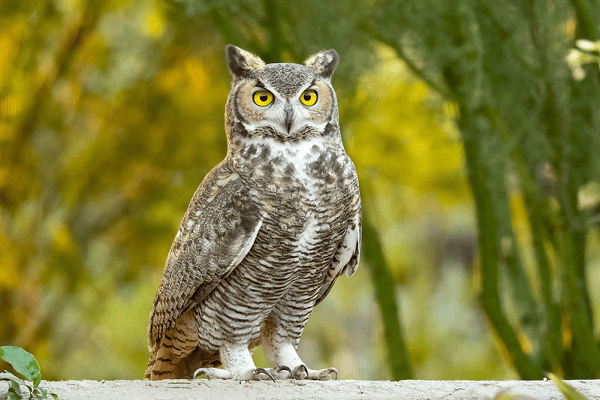
When it comes to love, these owls are early birds. They start looking for a nest spot as early as January. The guys put on impressive shows to impress the ladies, stomping around like they own the place.
But here’s the twist: instead of building their nests, they move into old homes left behind by other big birds. They’re like the Airbnb of the owl world, choosing spots from caves to cacti.
Now, let’s talk food. Great Horned Owls are foodies. They munch on small mammals like voles, mice, and rabbits. But they’re not picky – they’ll snack on birds, reptiles, bugs, and even other creepy crawlies.
When times get tough, they switch up their menu. These night hunters use their sharp claws and beaks to catch their meals. But here’s the sad part: human activity has hit their population hard. Cars, power lines, and poison have taken a toll.
3. American Barn Owl
- Scientific name: Tyto furcata
- Life span: 10 years
- Size: 34 to 38 cm
- Weight: 400 to 600 g
- Wingspan: 29 to 36 cm
- Status: Least Concern
The American Barn Owl is a ghostly beauty, hiding by day and hunting by night. With pale brown wings and a white face, it’s part of a group that includes Western and Eastern Barn Owls. Also, These owls are shrouded in myths, seen as mystical beings.
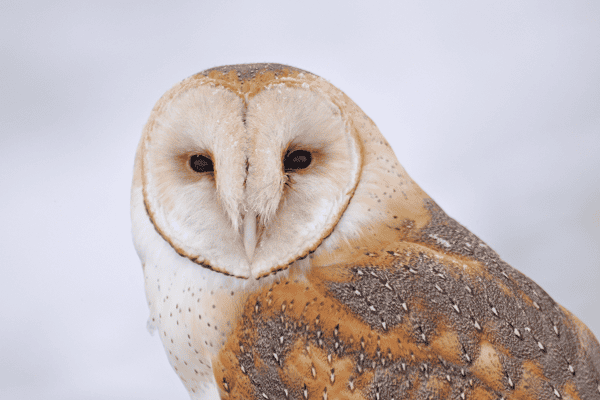
From March to June, they find a mate for life. The male owl picks a cozy spot like a tree hole for their home. They show off with fancy flying to win over a mate.
In Alabama, they eat mostly small animals like voles and mice. Their ears are super good at hearing prey, even in the dark. They need to eat a lot because they have a fast metabolism.
Sometimes, they’ll snack on birds and bugs too, but they love those Alabama rodents the most.
4. Barred Owl
- Scientific name: Strix varia
- Life span: 8 years
- Size: 40 to 63 cm
- Weight: 610 to 1,150 g
- Wingspan: 96 to 125 cm
- Status: Least Concern
Barred Owls, with their homey range of just 6 miles, are still found all over eastern North America and southern Canada. They’re easy to spot with their brownish-grey feathers and dark stripes.
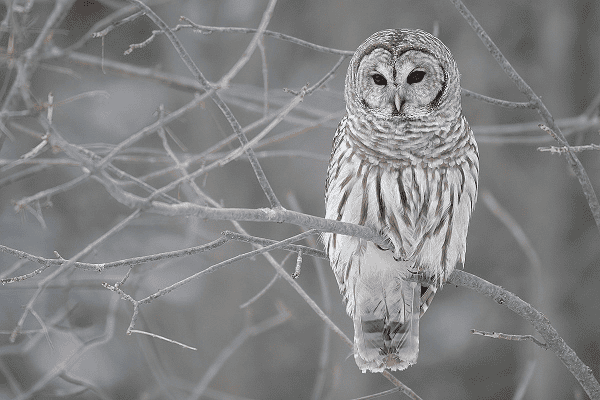
These owls are all about commitment, pairing up for life during February’s love season. They’re DIY experts, making nests in tree trunks in thick forests.
Their menu? Mostly small critters like mice and voles, but they’ll go for birds, reptiles, and insects too. Sometimes, they’ll even munch on bigger snacks like rabbits and squirrels.
They’ve got super hearing, which helps them hunt near rivers and wetlands. And they’re not picky – they’ll scavenge if they need to.
There are about 3 million Barred Owls out there, so they’re doing okay. But they still need our help to keep their homes safe from harm.
5. Short-eared Owl
- Scientific name: Asio flammeus
- Life span: 12 years
- Size: 34 to 43 cm
- Weight: 206 to 475 g
- Wingspan: 85 to 110 cm
- Status: Least Concern
The Short-Eared Owl is a fascinating bird found all over the world. Unlike most owls, it’s a daytime hunter. Also, These owls are social butterflies, living in flocks and nesting on the ground in places like prairies and meadows.
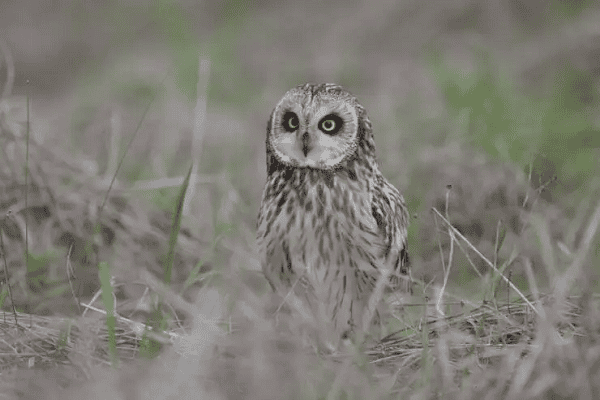
Their menu includes small mammals like voles and shrews, but they’re not picky – they’ll snack on rabbits, weasels, and even insects. They’re like the ultimate buffet hunters, flying low to the ground during the day.
Sadly, their population has taken a hit due to habitat loss and car accidents. But they’re still hanging in there, expanding their territory globally. Let’s root for these ground-loving owls!
6. Long-eared Owl
- Scientific name: Asio otus
- Life span: 10 to 27 years
- Size: 31 to 40 cm
- Weight: 160 to 435 g
- Wingspan: 86 to 102 cm
- Status: Least Concern
The Long-eared Owl masters the art of disguise with its brown and black feathers, blending seamlessly into the forest. This owl is a global dweller, known for its eerie calls that echo through the woods.
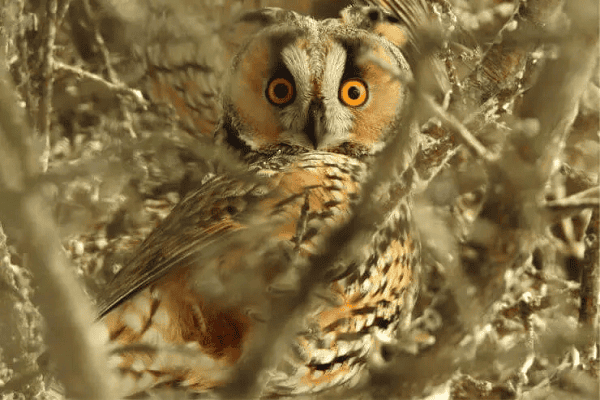
Come March, the breeding season kicks off. The males sing and flap their wings to claim their space, while the females scout for cozy nests, often borrowing from hawks.
In Alabama, these owls feast on small mammals like mice and voles, but they also snack on insects and birds. When food is scarce, they’ll dine on amphibians and reptiles.
Perched high, they wait for the perfect moment to pounce, or they might swoop low for a ground hunt. It’s all about patience and precision for these stealthy hunters.
Check Our Previous Articles:
7. Northern Saw-whet Owl
- Scientific name: Aegolius acadicus
- Life span: 7 to 17 years
- Size: 17 to 22 cm
- Weight: 54 to 151 g
- Wingspan: 42 to 56.3 cm
- Status: Least Concern
The Northern Saw-Whet Owl is a tiny, secretive owl found all over North America, including Alabama. It’s known for its cream and brown-streaked round face, sharp beak, and big yellow eyes. Its belly is white with brown spots, and its back is dark brown with white dots.
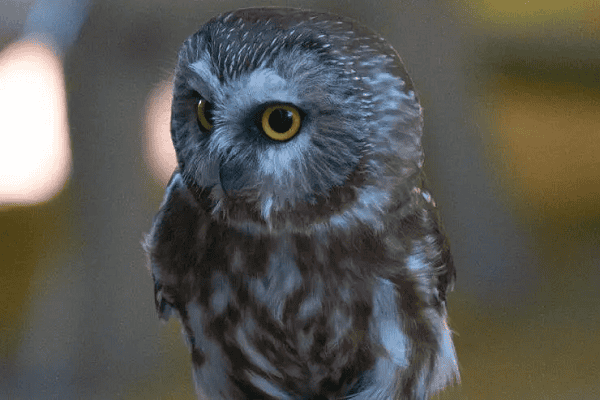
This owl gets its name from its call, which sounds like a saw being sharpened. During breeding season in March, these owls pair up for life, but sometimes males have more than one mate if there’s lots of food. They nest in holes made by woodpeckers or in boxes we put up.
In Alabama, they hunt small animals like voles and mice, plus insects and other little critters. They’re really good at catching their food with their strong claws and beak, even bigger prey than themselves.
Where to Spot for Owls in Alabama
Exploring Olws in Alabama are nature preserves and parks is a fantastic way to spot owls. Wheeler National Wildlife Refuge is great for seeing Great Horned and Barred Owls, while Bon Secour National Wildlife Refuge is the place to find Eastern screech owls.
For a chance to see the Northern Saw-whet Owl, try Sipsey Wilderness, and for Barred Owls, Cheaha Wilderness is perfect. Remember, these natural habitats are accessible but deserve our respect.
Not into hiking? No problem! Join a guided birdwatching tour with local clubs. It’s a fun way to learn and increases your chances of seeing these majestic birds.
Birdwatching is not just about spotting birds; it’s about connecting with nature and fellow enthusiasts. Just keep in mind, always watch owls from afar to keep them safe and undisturbed.
Final Thoughts:
In the end, Owls in Alabama is indeed a paradise for owl aficionados and birdwatchers. The state’s rich tapestry of ecosystems provides the perfect backdrop for the lives of these intriguing nocturnal creatures. Whether it’s the secretive Northern Saw-Whet Owl or the regal Great Horned Owl, each species adds a unique note to the symphony of the forest. Their calls, echoing through the trees, truly enhance the immersive experience of being in the wild, connecting us to the natural world in a profound way. It’s a reminder of the beauty and diversity of wildlife that thrives in Alabama’s landscapes.

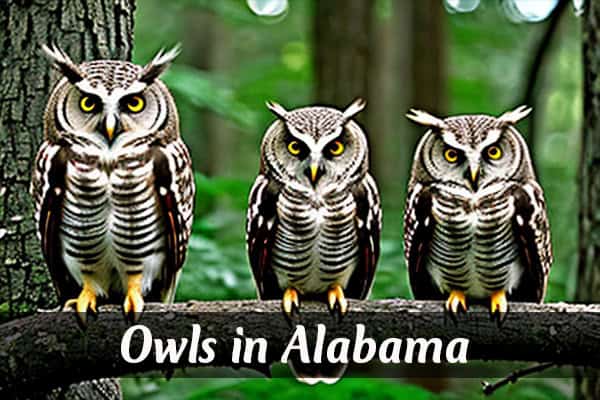

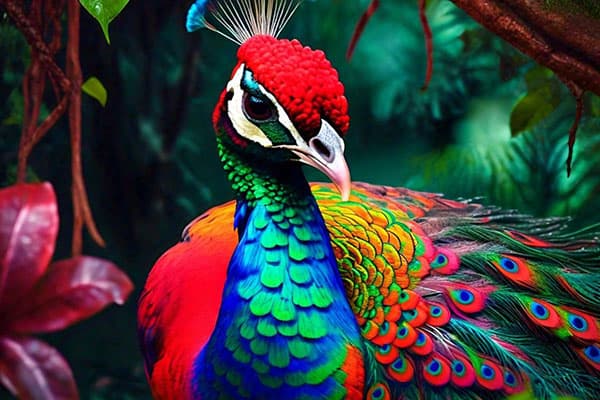
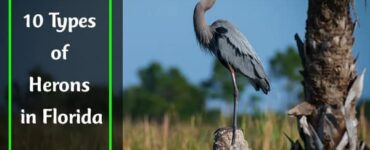
Add comment